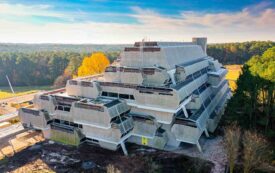Event JSON
{
"id": "6eb05366847b6605c3bfecda6bfad85804e457465ebe810721ffc83990a8979a",
"pubkey": "4202ee0798cfe925051e4bb0f87d66ae907ec07248d2b540b48f93cb2df38bb1",
"created_at": 1738588539,
"kind": 1,
"tags": [
[
"r",
"https://www.thenation.com/article/culture/brutalism-met-movie-architecture/"
],
[
"subject",
"The Dubious Return of the Brutalists"
],
[
"published_at",
"1738576800"
],
[
"image",
"https://www.thenation.com/wp-content/uploads/2025/01/Elionhitchingsbuilding2020_1-275x173.jpeg"
],
[
"p",
"4202ee0798cfe925051e4bb0f87d66ae907ec07248d2b540b48f93cb2df38bb1",
"wss://articles.layer3.news"
],
[
"imeta",
"url https://www.thenation.com/wp-content/uploads/2025/01/Elionhitchingsbuilding2020_1-275x173.jpeg"
],
[
"t",
"liberal:perspective"
],
[
"summary",
"Brutalism emerged in the 1950s as a reaction to the sleek, modernist architecture of the previous decade. It emphasized the use of raw concrete, exposed ductwork, and a focus on function over form. Paul Rudolph, a leading Brutalist architect, designed buildings that were both aesthetically pleasing and socially conscious. However, his work was also criticized for its lack of concern for human scale and its contribution to urban renewal schemes that displaced low-income communities. The article explores the tension between Brutalism's artistic and social aspects, highlighting the ways in which it reflects and shapes societal values."
]
],
"content": "nostr:nprofile1qyd8wumn8ghj7ctjw35kxmr9wvhxcctev4erxtnwv4mhxqpqggpwupucel5j2pg7fwc0sltx46g8asrjfrft2s9537fukt0n3wcs9lsefw\nhttps://www.thenation.com/wp-content/uploads/2025/01/Elionhitchingsbuilding2020_1-275x173.jpeg\nDaniel Brook Why the stark 20th-century architectural style is back in vogue. The post The Dubious Return of the Brutalists appeared first on The Nation.\nhttps://www.thenation.com/article/culture/brutalism-met-movie-architecture/",
"sig": "ffd9d31b4f59e7adc6b008bb136609b4ccdbbe5759bbeea3b21e4fbe3b537f524866832d71234604163024a7fbc571a47538434cb926ff0f6ed4a0a26def84a0"
}


